Most visitors don’t know Dead Horse Ranch is actually four separate campgrounds, each with a different feel and access to the Verde River. You’ll find riverside birding at Sycamore, quieter tent spots at Mesquite, full RV facilities at Cottonwood, and group-friendly Verde areas — but choosing the right one changes your whole trip. Keep going to pick the best site, learn reservation details, and get practical backcountry tips that matter.
Overview of Dead Horse Ranch State Park Campgrounds
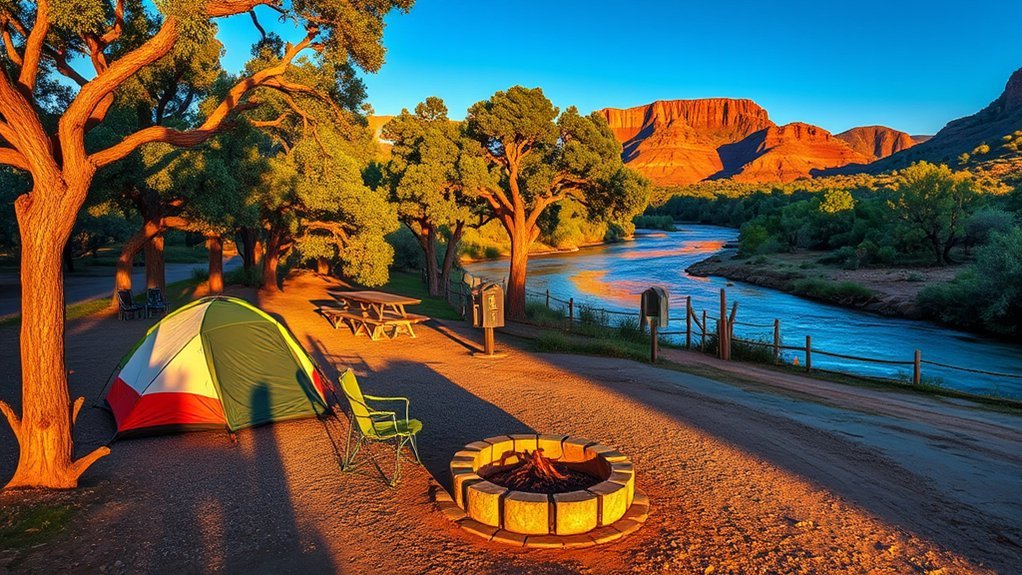
Dead Horse Ranch State Park offers four distinct campgrounds—Sycamore, Cottonwood, Mesquite, and Verde—that let you choose between riverside sites, shady cottonwood groves, and open RV-friendly loops. You’ll find campground amenities like picnic tables, fire rings, flush toilets, potable water, and RV hookups varying by loop, plus accessible sites near trailheads. Each campground gives a different feel: Sycamore hugs the river for birding and easy walks, Cottonwood shelters you under mature trees, Mesquite offers quieter tent-focused pitches, and Verde handles larger rigs. Visitor activities spill directly from your site — biking and hiking trails, fishing, paddling, and wildlife viewing start nearby. You’ll get clear maps and staff advice so you can pick a spot that matches your priorities.
Making Reservations and Fees
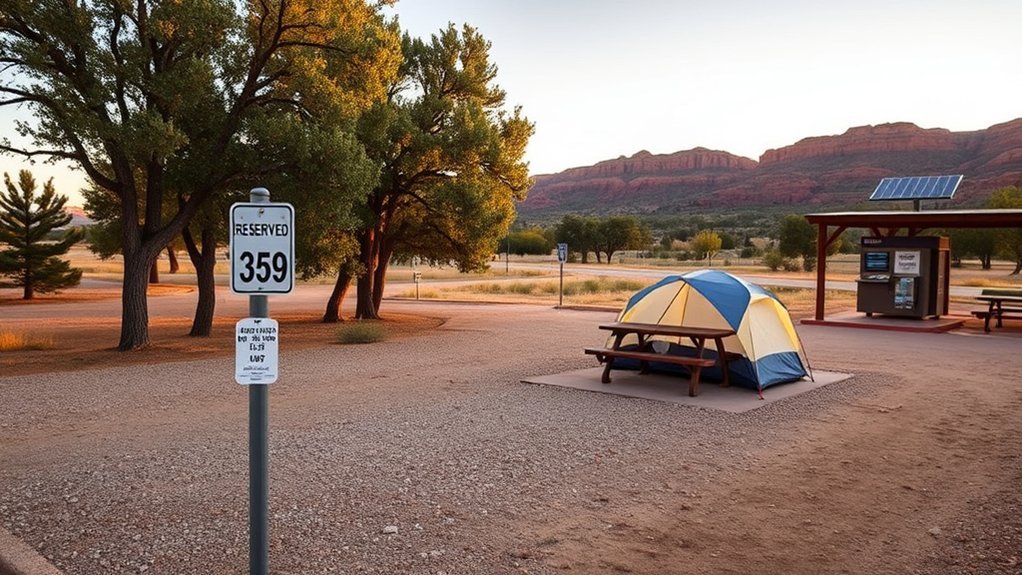
When you’ve picked the campground that fits your needs, the next step is reserving your site and understanding what it will cost. You’ll use the park’s online system or call the reservation line; familiarizing yourself with reservation policies helps you know cancellation windows, hold times, and peak-season rules. Pay attention to nightly versus per-stay fee structures, plus extra charges for additional guests or vehicle permits. Book early for holiday weekends and flexible dates to snag lower rates. When you arrive, keep your reservation confirmation and ID handy—staff may verify your booking. If plans change, follow the stated refund and transfer procedures to avoid penalties. Clear expectations on policies and fees make your trip smoother and less stressful.
RV Sites, Hookups, and Dump Station Details
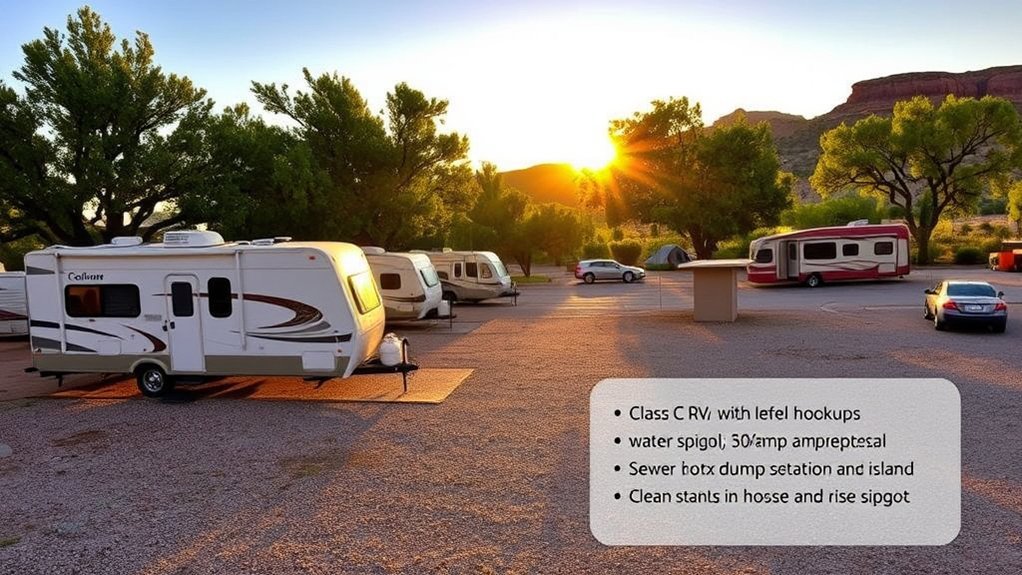
RV camping at Dead Horse Ranch State Park offers a mix of full-hookup and partial-hookup sites so you can pick the level of convenience you need. You’ll find rv site amenities like picnic tables, fire rings, and level pads; many sites include 30/50 amp electric and water, while partial-hookup spots may offer only electric. When you arrive, check your reservation for specific hookup options so you’re not caught short. The park’s dump station is centrally located, accessible during daylight hours, and designed for straightforward, sanitary dumping and rinsing. Staff keep it maintained, but you should bring proper adapters and hoses. Overall, hookups are reliable; plan supplies accordingly and back in confidently knowing basic services are available.
Tent Sites and Family-Friendly Spots
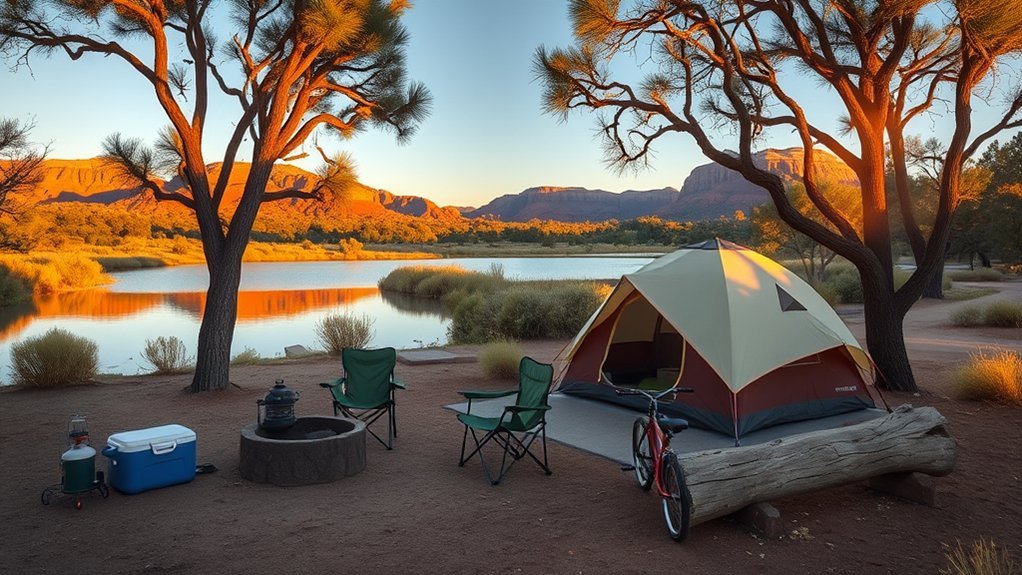
You’ll find level, shaded tent pads that make pitching easy and comfortable, even on sunny afternoons. Several looped sites cater to groups, so you can camp close to friends while still having privacy. Playgrounds and nearby restrooms keep kids happy and make trips more convenient for families.
Level, Shaded Tent Pads
If you want a comfortable, family-friendly spot, choose one of Dead Horse Ranch’s level, shaded tent pads—each gives you a stable, easy-to-pitch surface and plenty of tree cover to keep temps down and gear out of direct sun. You’ll appreciate how shaded tent pads reduce midday heat, protect nylon and pads, and create a cooler sleeping environment for kids. Set up near the pad’s edge to keep a small cooking area wind-protected but off the sleeping surface. Bring a tarp for extra rain protection and a low-profile lantern to avoid attracting insects. Check pad size before you arrive to confirm your tent and gear fit without crowding. These pads balance camping comfort with straightforward, stress-free setup.
Group-Friendly Loop Sites
Several looped sites at Dead Horse Ranch are built for groups and families, giving you roomy tent areas, nearby picnic tables, and enough separation to feel private without losing access to shared amenities. You’ll find sites that handle varied group dynamics — from multi-family gatherings to scout troops — with space for several tents and a clear layout that keeps gear organized. Paths and parking areas are convenient, so setup and late arrivals won’t disrupt the group. Plan campfire activities on designated rings, respecting quiet hours and fire rules, and bring games that suit mixed ages. You’ll appreciate the balance of communal space and private corners, letting your group socialise comfortably while keeping small kids and gear contained.
Nearby Playground & Restrooms
One short walk from many tent and family-friendly loops, the playground and nearby restrooms make day-to-day camping easier and more fun for kids and caregivers alike. You’ll find durable playground equipment—slides, swings, and climbing structures—set on soft surfacing so little ones can burn energy close to camp. Sightlines from picnic tables let you keep an eye on kids while you prep meals or relax. Restroom accessibility is good: flush toilets, sinks, and baby-changing stations are kept clean, and accessible stalls accommodate mobility needs. At peak times you may wait a few minutes, so plan showers or diaper changes accordingly. Overall, this combination of play and facilities reduces stress, lets you stick to routines, and keeps family camping pleasant and practical.
Group Camping Areas and Policies
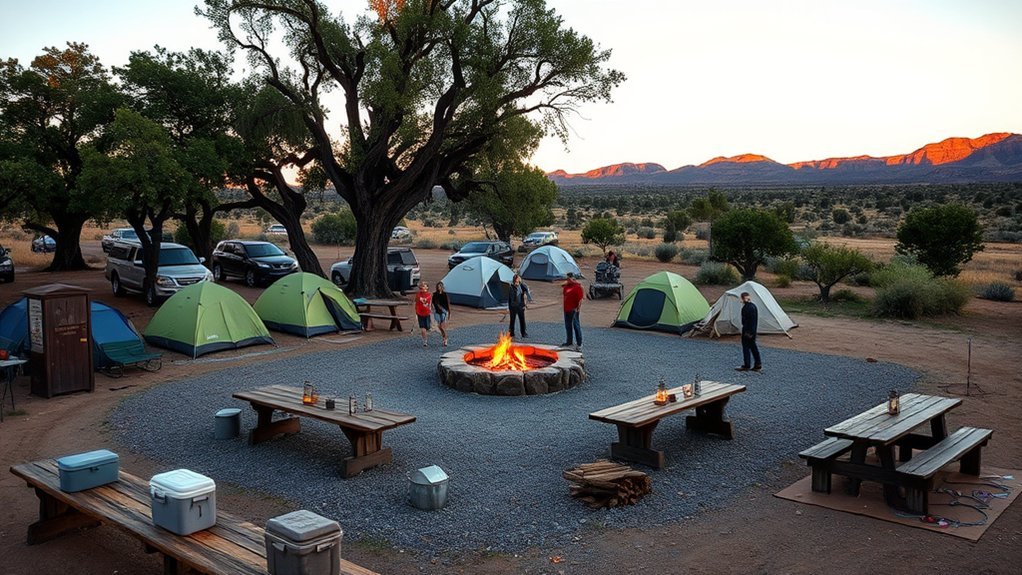
While group sites at Dead Horse Ranch State Park accommodate large parties, you’ll want to reserve early to secure preferred dates and layouts. You’ll find clear reservation policies online; check group size limits before booking so your party fits allotted space and fees. Expect designated areas separated from individual campsites for privacy and quieter evenings.
- Contact the park or use the online portal to confirm availability and any permits required.
- Review arrival/departure times, vehicle limits, and extra-tent rules to avoid surprises.
- Follow campsite rules on noise, fires, and leave-no-trace practices to keep the group welcome.
- Prepare for contingencies: nearby overflow options, bad weather plans, and a point person for park communication.
Park Facilities: Restrooms, Showers, and Picnic Areas
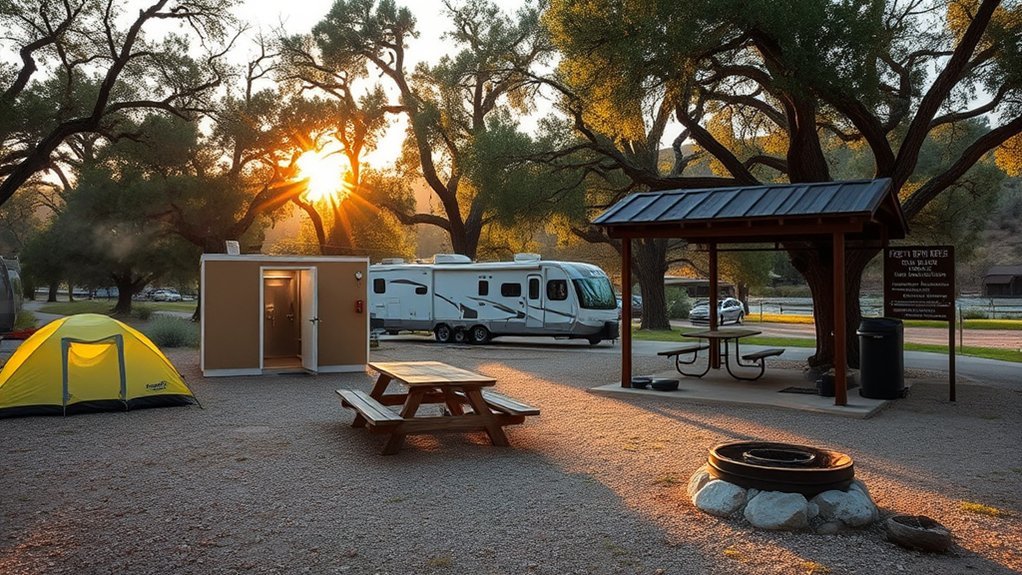
Clean, well-marked restrooms, coin-operated showers, and shaded picnic ramadas make it easy to stay comfortable at Dead Horse Ranch State Park. You’ll appreciate restroom cleanliness—park staff keep facilities tidy, supplies stocked, and trash emptied regularly, though weekends can be busier. Shower stalls are simple and functional; bring quarters and a quick towel for efficient use after a dusty day. Picnic ramadas offer tables, grills, and shade, so you can relax without unpacking heavy gear. Picnic area amenities include nearby trash receptacles, accessible parking, and drinking water in many spots, which helps you plan meals and cleanup. You’ll still want to carry hand sanitizer, secure food from wildlife, and check facility hours on busy holiday weekends.
Trails, River Access, and Day-Use Tips
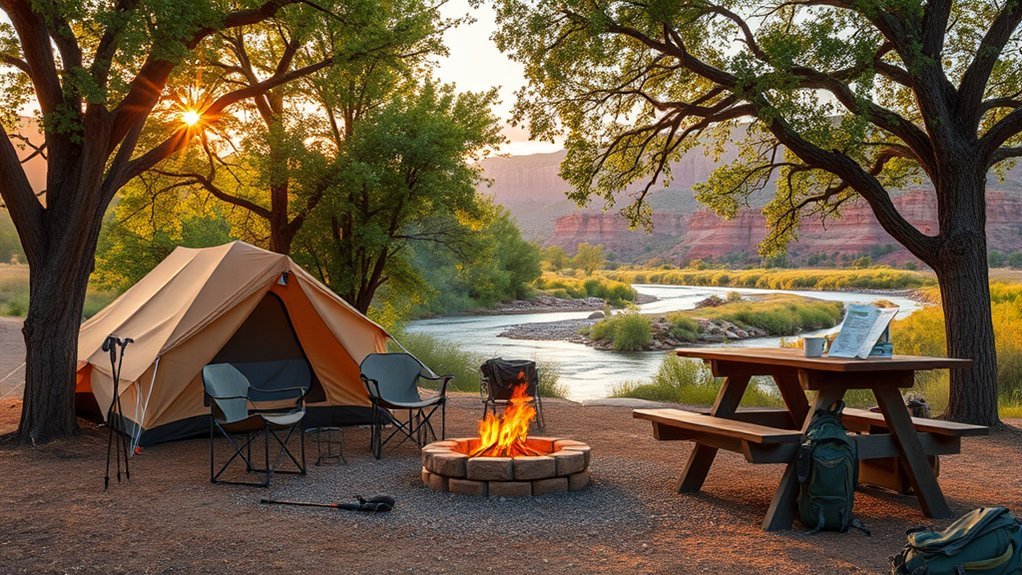
After you’ve freshened up or packed a picnic, head out to the park’s network of trails and river access points to make the most of your day. You’ll find well-marked paths for short strolls or longer hikes, plenty of benches, and clear access to the Verde River for river activities like wading, fishing, or quiet paddle trips. Aim for early morning or late afternoon for cooler air and softer light at scenic viewpoints. Pack water, sun protection, and a small trash bag.
Freshen up, pack a picnic, and explore trails and Verde River access for peaceful hikes, wading, or paddles.
- Choose trails by length and difficulty posted at trailheads.
- Use river access spots for safe entry and to avoid bank erosion.
- Bring a map or download an offline route.
- Respect wildlife and quiet zones.
Backcountry Planning: Water, Navigation, and Permits
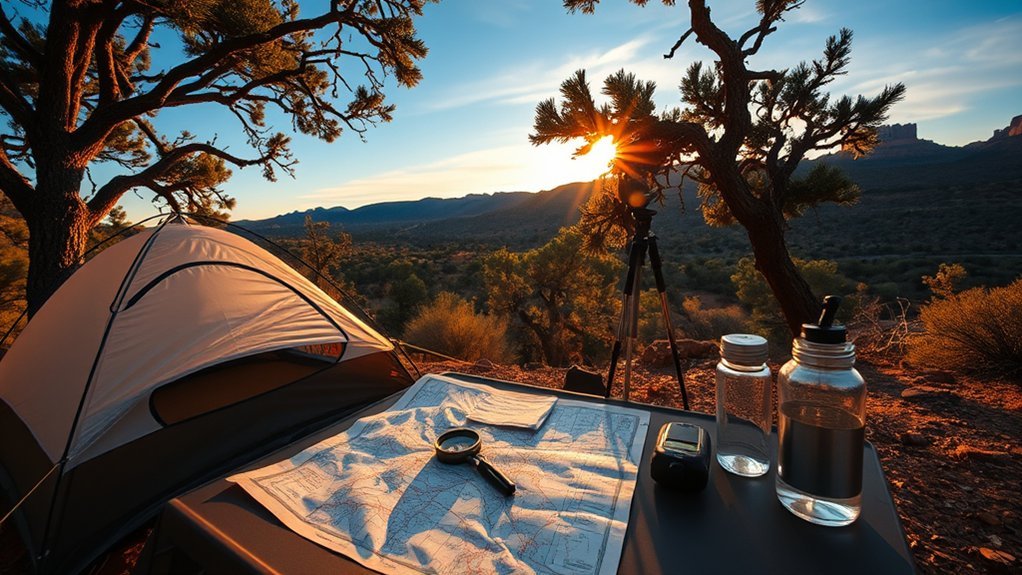
Because water and navigation mistakes can turn a great trip into a rescue call, plan your backcountry outings with care: know how much water you’ll need and where to replenish it, carry reliable maps and a GPS or compass, and check permit requirements for overnight stays or special-use areas before you go. You should calculate backcountry water needs by distance, temperature, and exertion, and identify springs, river access points, or treated-water caches on your route. Pack a lightweight filter or chemical treatment as backup. Review navigation tips: study contours, trail junctions, and waypoint coordinates, and practice using your GPS and compass before heading out. Confirm permit rules with park staff, carry permits visibly, and respect group-size limits and campsite rules.
Wildlife Safety and Leave No Trace Practices
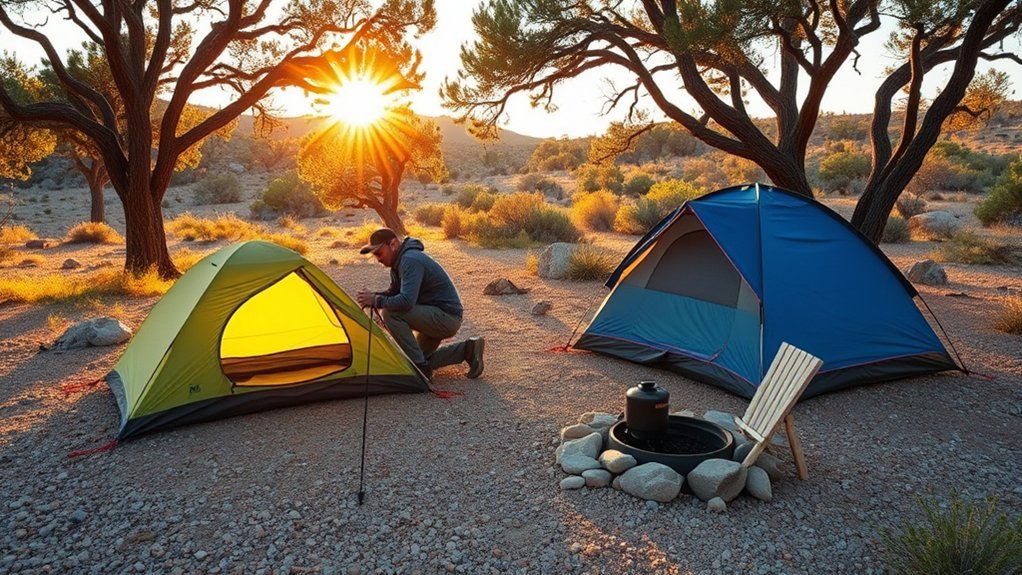
Water and navigation planning will get you where you want to go, but once you’re out there you’ll also need to minimize your impact and keep wildlife safe. You’ll practice quiet observation, store food properly, and know how to react to wildlife encounters without escalating them. Trail safety means staying on durable surfaces and yielding to others to protect habitat.
Plan your route, minimize impact, observe quietly, secure food, and stay on trails to protect wildlife and habitat.
- Carry bear- and critter-proof containers, hang food when required, and never feed animals.
- Keep a safe distance; use binoculars or a zoom lens to observe behavior without disturbing wildlife.
- Pack out all trash, food scraps, and hygiene products—leave no trace of your visit.
- Follow trail safety: stay on marked routes, avoid short-cutting, and respect seasonal closures.
Seasonal Considerations and Weather Preparedness
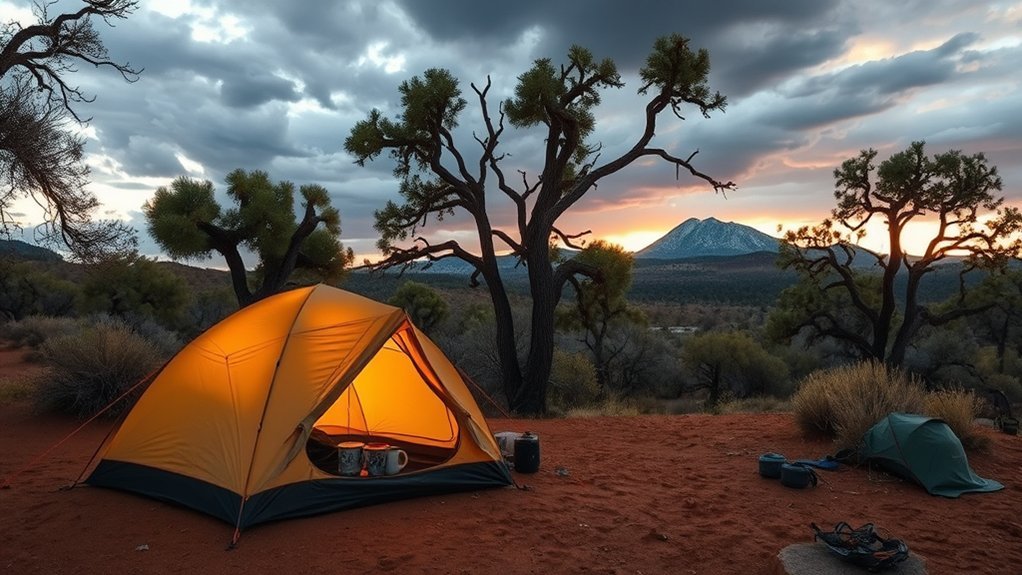
Expect wide temperature swings at Dead Horse Ranch—hot afternoons and cool nights in summer, chilly winters—and pack layers so you’re comfortable from dawn to dusk. Watch the seasonal monsoon forecast between July and September, since brief but intense rains can trigger flash floods in low-lying areas and along washes. Stay updated on weather alerts, move your camp uphill if water starts rising, and secure gear against sudden storms.
Seasonal Temperature Ranges
Although temperatures swing dramatically through the year, you can plan camp gear and activities around predictable seasonal patterns: summers bring hot, dry days often topping the 90s°F (32–37°C) with cool nights, while winters deliver chilly daytime highs in the 40s°F (4–9°C) and nights that can dip below freezing. Expect clear spring warmth, brisk fall evenings, and notable temperature variations from day to night. Tailor layers and timing for seasonal activities and comfort.
- Pack breathable sun protection and light layers for hot days, plus a warm jacket for nights.
- Choose a sleeping bag rated below expected night lows; add a liner for winter.
- Plan hikes early or late in summer to avoid peak heat.
- Monitor forecasts and adjust plans for unexpected cold snaps.
Monsoon and Flash Floods
When summer storms roll in from late July through September, they’ll bring brief but intense monsoon downpours that can turn washes and riverbeds into fast-moving flood channels—so watch skies, avoid low-lying campsites, and don’t try to cross swollen streams. You’ll want clear monsoon preparation: check forecasts, pick campsites on higher ground, and stash gear in waterproof bags. Learn local escape routes and signal locations; flash floods can arrive with little warning. At night, listen for distant thunder and rising water sounds. For flood safety, move to higher terrain immediately if water appears, even if nearby areas seem dry. After storms, inspect tent sites for debris, avoid damaged trails, and report hazards to park staff so others stay safe.
Frequently Asked Questions
Are Campfires Allowed Year-Round in All Campsites?
No — you won’t have campfires allowed year-round in all campsites. You’ll follow campfire regulations, check local restrictions and seasonal closures, and practice fire safety so you don’t cause wildfires or violate park rules.
Is Cell Service Reliable Inside the Park?
Mostly no—don’t expect constant bars; cell coverage and signal strength vary wildly. You’ll get intermittent service near park edges or trailheads, so plan for limited reception and download maps or alerts before you enter.
Can I Bring My Dog on Trails and to River Access Points?
Yes — you can bring your dog on trails and river access points; the park has dog friendly trails, but you’ll keep pets leashed, clean up waste, watch for wildlife, and prioritize pet safety around water and heat.
Are Bicycles Allowed on All Park Trails?
No, bicycles aren’t allowed on all trails. You’ll follow bicycle regulations: bikes are permitted on designated multiuse and paved routes, but some natural-surface or sensitive trails restrict cycling to protect trail accessibility and habitat.
Is There a Nearby Store for Forgotten Camping Supplies?
Yes — nearby stores stock camping essentials. Swift small local shops in Cottonwood and Clarkdale sell gear, snacks, and supplies; you’ll grab forgotten items quickly, ask staff for recommendations, and get back to your campsite fast.
Conclusion
You’ll leave Dead Horse Ranch with river-scented clothes and a map of footprints in your memory—easy sites by cottonwoods, quiet tent nooks, or a rugged backcountry route where every sip matters. Pack water, navigation, and Leave No Trace gear, check weather, and book ahead for hookups or groups. Stay alert for wildlife and monsoon shifts; do that, and the next dawn’s light through sycamores will feel like it’s waiting just for you.

